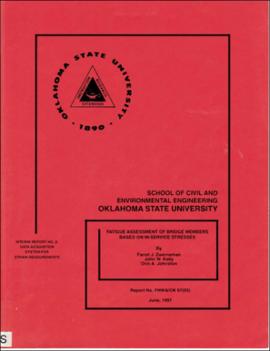| dc.description.abstract | When a bridge is designed, conservative assumptions are made with regard to load distribution and structural continuity. Simple support is assumed when rotational restraint exists, deck girders are assumed noncomposite when significant shear transfer occurs at service loads, haunch is ignored, and elements such as railing are treated as nonstructural dead load rather than as stiffening elements. As a result of these and other conservative assumptions, stresses calculated for design may be well above stresses computed on the basis of strains measured while the bridge is in service. The magnitude of the stress fluctuations under service load determines the fatigue life of the bridge. The accuracy of remaining fatigue life estimates can be improved if these estimates can be based on measured rather than computed strains, typically resulting in a significant increase in projected bridge life. A more accurate fatigue life estimate leads to fewer negative fatigue life computations for operating, undamaged bridges. The result is an overall reduction in retrofit and replacement costs.' To take advantage of this cost savings, a data acquisition system has been constructed for use by the Oklahoma Department of Transportation in measuring strains on in-service bridges. Construction of the system involved the development of hardware and software to facilitate interaction with a general-purpose commercial datalogger. Application of the system requires the user to install strain gages on the structure of interest, extend leadwires from the gages to a junction box containing bridge completion circuitry, connect the junction box to a battery-powered datalogger, and connect the datalogger to an on-site computer. The computer is loaded with software to assist the user in setting up the datalogger and downloading collected data. This report contains information regarding construction of the data acquisition system which may be useful for system maintenance and operation. This report also contains a set of general guidelines for conducting a bridge test and applying the test results. It is recommended that a complete bridge evaluation include a thorough visual inspection, an analysis of the structure, and a load test. The load test should include both a series of short-term tests in which stresses are recorded as a truck of known weight passes over the bridge, and at least one long-term test in which the number and magnitude of stress cycles are recorded under normal traffic. Data collected using the data acquisition system can be used to estimate remaining fatigue life and set inspection intervals. The recommended procedure for estimating remaining fatigue life follows NCHRP Report 299, taking full advantage of the fact that stresses are measured rather than computed. The procedure for setting inspection intervals is based on a fracture mechanics estimate of the time required for a crack of an assumed initial length to grow to a critical length when driven by the measured stress cycles. | |
